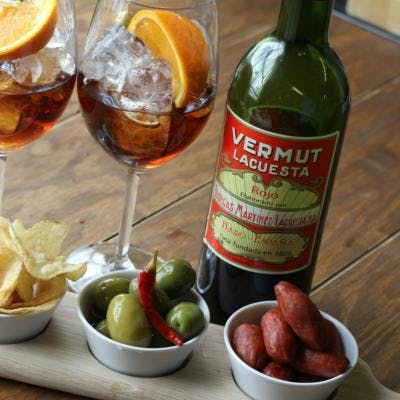
5 things you never knew about vermouth
When you think of vermouth, it’s likely either as a supporting ingredient in some of your favourite cocktails, or, at worst, as that ancient bottle gathering dust at the back of your drinks cabinet.
In France, Italy and Spain, however, where it is traditionally made, vermouth is the star of the show, enjoyed neat or over ice as a sophisticated aperitif.
In northern Spain, home to both the Siderit Gin and the Lacuesta Rojo Vermouth in your box this month, there is a particularly strong tradition of drinking straight vermouth. On Sundays, family and friends will gather to enjoy the drink alongside tapas during la hora del vermut, or ‘vermouth time’, between Church mass and lunch.
In recent years, boosted by the growing interest in craft drinks, vermouth has grown rapidly in popularity here in the UK, becoming something of a trend. Here are just a few reasons why we think this deliciously complex tipple is ripe for rediscovery.
1. It’s wine – but stronger
Vermouth contains at least 75% wine, most commonly derived from white grapes, which is then strengthened (or ‘fortified’) with extra booze, often a form of grape brandy, and sugar. Consequently, the alcoholic content of vermouth is higher than that of wine, falling in the 16-20% ABV range. The Lacuesta Rojo Vermouth in your box this month uses a white wine base created from grapes harvested from several of the Martinez Lacuesta winery’s Rioja vineyards.
2. Its botanical bounty rivals gin
Like gin, vermouth is created by macerating a blend of botanicals in alcohol, with each producer closely guarding its own secret recipe. Vermouth in fact takes its name from the German name of one key botanical, Wermut, or wormwood, a bitter, medicinal herb that is also a key component in absinthe.
Lacuesta Vermouth’s unique botanical recipe has remained the same since 1934. Twenty-four different botanicals are macerated in wine then aged in American oak barrels for three years, before being blended with more wine and finally aged for another three months in French oak.
3. There are a range of styles
The two main types of vermouth are sweet and dry, commonly also known as Italian and French vermouth respectively, in reference to the countries where each was first produced. There are now also numerous additional variations available, including extra-dry white, sweet white (bianco), amber (ambre) and rosé.
While at the sweeter end of the spectrum, your bottle of Lacuesta Rojo Vermouth treads a graceful line between sweet and dry, combining dried orange and cinnamon flavours with more herbal, bitter notes to create a lovely balance.
4. It needs to be drunk fresh
Just like wine, vermouth oxidises once opened, although the higher alcohol content means it can last a little longer. Keep bottles tightly closed, in the fridge or at least somewhere cool, and away from light to keep your vermouth palatable for three to six months. If you don’t use it very often, it’s a good idea to buy smaller bottles to ensure your stash stays fresh.
5. It’s a cocktail essential
Vermouths both dry and sweet form the backbone of many a classic cocktail – perhaps most famously that simple blend of gin and vermouth, the Martini, as well as Italian favourite, the Negroni.
The Marianito, particularly popular in the northern Basque, La Rioja and Burgos regions, is Spain’s answer to the Negroni. Javier De La Hormaza of Basco Fine Foods, UK-based purveyors of Spanish gourmet products, including Lacuesta Vermouth, explains: “Some say that the drink originated in Bilbao as a way of serving a prepared vermouth, others say that it was invented by somebody named Mariano. The truth is that Marianito is a more sophisticated way of drinking vermouth, simply than on its own.”
Whatever its origins, this simple yet delicious drink is a great way to show off both the Lacuesta Rojo Vermouth and the Siderit Gin in your box this month. ¡Salud!







